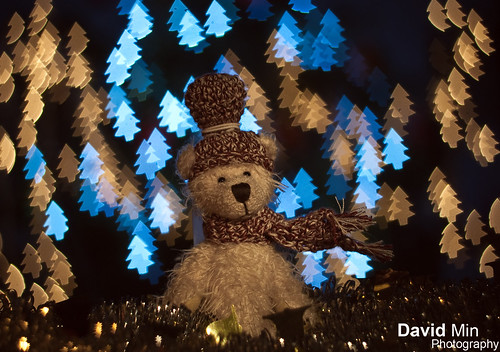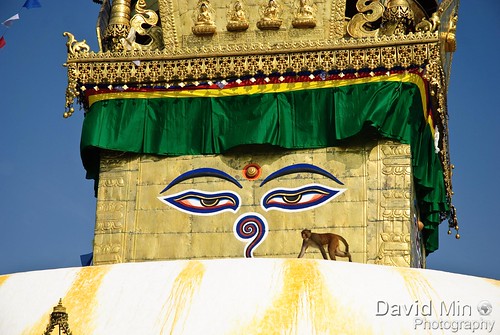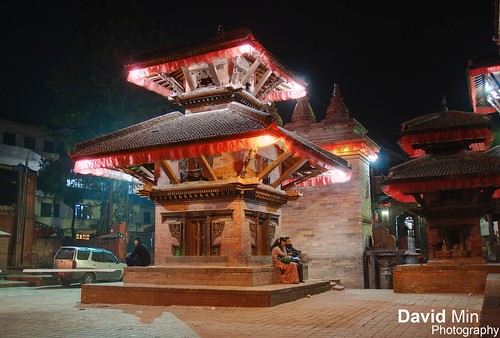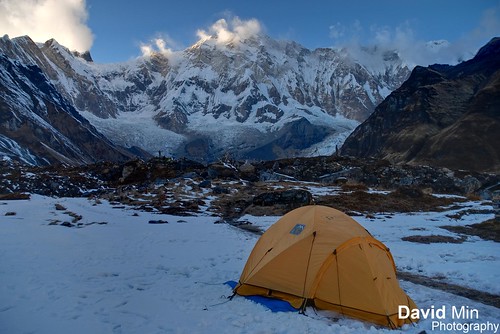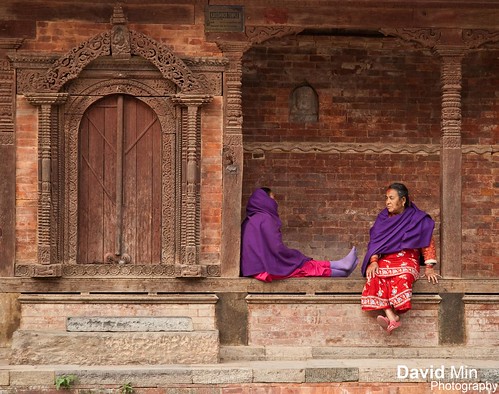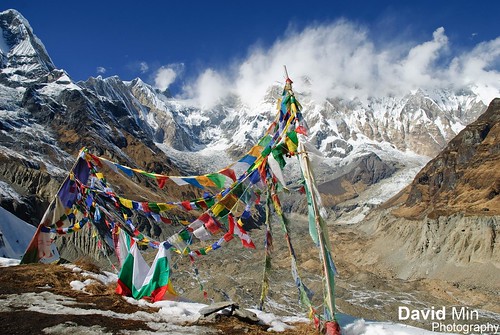Annapurna III is a 24,787 ft / 7,555 m mountain peak in the Himalayas in Nepal. Based on peakery data, it ranks as the 20th highest mountain in Nepal. The nearest peaks are Gangapurna, Canharba Chuli, Tharpu Chuli, Machapuchhare, Tarke Kang, and Singu Chuli.
Annapurna III was first climbed in 1961 by an Indian expedition led by Capt. Mohan Singh Kohli, via the Northeast Face. The summit party comprised Mohan Kohli, Sonam Gyatso, and Sonam Girmi.
Monday, December 26, 2011
Annapurna III (7 555m), Nepal - Looking at the Immensity
Saturday, December 24, 2011
Merry Christmas / Joyeux Noël / Feliz Navidad
Monday, December 19, 2011
Kathmandu, Nepal - Monkey Temple
Swayambhunath is an ancient religious complex atop a hill in the Kathmandu Valley, west of Kathmandu city. It is also known as the Monkey Temple as there are holy monkeys living in parts of the temple in the north-west. The Tibetan name for the site means 'Sublime Trees', for the many varieties of trees found on the hill.
For the Buddhists, Swayambhunath occupies a central position, it is probably the most sacred among Buddhist pilgrimage sites. For Tibetans and followers of Tibetan Buddhism, it second only to Boudhanath.
The Swayambhunath complex consists of a stupa, a variety of shrines and temples, some dating back to the Licchavi period. A Tibetan monastery, museum and library are more recent additions. The stupa has Buddha's eyes and eyebrows painted on. Between them, there is something painted which looks like the nose - but is the Nepali symbol of 'unity', in the main Nepali language dialect.
Sunday, December 18, 2011
Annapurna I (8 091m) @Sunrise - 10th Highest Mountain in the World
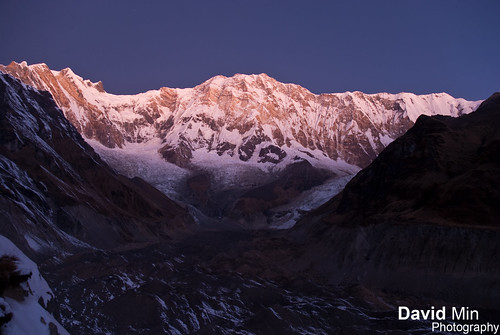
Annapurna I (8 091m) @Sunrise - 10th Highest Mountain in the World, a photo by GlobeTrotter 2000 on Flickr.
Annapurna I (8 091m) - located in Nepal - is the most dangerous 8000-meter peak with an expedition fatality rate of 40%. In particular, the ascent via the south face is considered the most difficult of all climbs.
Annapurna I was the first 8,000-meter peak climbed and the first climbed without supplemental oxygen.
Maurice Herzon and Louis Lachenal, the first to summit Annapurna I in 1950, were part of a French team that included other great climbers including Gaston Rébuffat and Lionel Terray. Herzog and Lachenal both suffered severe frostbite on their feet and Herzog on his hands after losing his gloves. Gangrene set in afterward, forcing the expedition doctor to amputate fingers and toes in the field without anesthetic.
Maurice Herzog wrote the book Annapurna about the 1950 expedition, which has sold over 11 million copies, making it the best-selling climbing book of all time.
Friday, December 16, 2011
Kathmandu, Nepal - Durbar Square
Durbar Square is the generic name used to describe plazas opposite old royal palaces in Nepal. Before the Unification of Nepal, Nepal consisted of small kingdoms, and Durbar Squares are most prominent remnants of those old kingdoms in Nepal. In particular, three Durbar Squares in the Kathmandu Valley, belonging to the three kingdoms situated there before unification, are most famous: Kathmandu Durbar Square, Patan Durbar Square, and Bhaktapur Durbar Square. All three are UNESCO World Heritage Sites.
The Kathmandu Durbar Square is surrounded by spectacular architecture and vividly showcases the skills of the Newari artists and craftsmen over several centuries. The royal palace was originally situated at Dattaraya square and was only later moved to the Durbar square location.
The Kathmandu Durbar Square holds the palaces of the Malla and Shah kings who ruled over the city. Along with these palaces, the square also surrounds quadrangles revealing courtyards and temples. The square is presently known as Hanuman Dhoka, a name derived from the statue of Hanuman, the monkey devotee of Lord Ram, near the entrance of the palace.
Monday, December 12, 2011
Annapurna Base Camp, Nepal - Frozen Morning
Annapurna is a section of the Himalayas in north-central Nepal that includes 8,091 metres (26,545 ft) Annapurna I, thirteen additional peaks over 7,000 m (22,970 ft) and 16 more over 6,000 m (19,690 ft).
The entire massif and surrounding area are protected within the 7,629 km2 Annapurna Conservation Area, the first and largest conservation area in Nepal. The Annapurna Conservation Area is home to several world-class treks, including the Annapurna Circuit.
The Annapurna peaks are the world's most dangerous mountains to climb although, from figures since 1990, Kangchenjunga surpasses Annapurna's death rate. As of 2007, there had been 153 summit ascents of Annapurna I, and 58 climbing fatalities on the mountain. This fatality to summit ratio (38%) is the highest of any of the eight-thousanders. In particular, the ascent via the south face is considered the most difficult of all climbs.
Sunday, December 11, 2011
Kathmandu, Nepal - Durbar Square
Durbar Square is the generic name used to describe plazas opposite old royal palaces in Nepal. Before the Unification of Nepal, Nepal consisted of small kingdoms, and Durbar Squares are most prominent remnants of those old kingdoms in Nepal. In particular, three Durbar Squares in the Kathmandu Valley, belonging to the three kingdoms situated there before unification, are most famous: Kathmandu Durbar Square, Patan Durbar Square, and Bhaktapur Durbar Square. All three are UNESCO World Heritage Sites.
The Kathmandu Durbar Square is surrounded by spectacular architecture and vividly showcases the skills of the Newari artists and craftsmen over several centuries. The royal palace was originally situated at Dattaraya square and was only later moved to the Durbar square location.
The Kathmandu Durbar Square holds the palaces of the Malla and Shah kings who ruled over the city. Along with these palaces, the square also surrounds quadrangles revealing courtyards and temples. The square is presently known as Hanuman Dhoka, a name derived from the statue of Hanuman, the monkey devotee of Lord Ram, near the entrance of the palace.
Saturday, December 3, 2011
Annapurna, Nepal - The Sanctuary
The Annapurna Sanctuary is “high glacial basin lying forty kilometers directly north of Pokhara. This oval-shaped plateau sits at an altitude of over 4000 meters, and is surrounded by a ring of mountains, the Annapurna range, most of which are over 7000 meters. With the only entrance a narrow pass between the peaks of Hiunchuli and Machapuchare, where run-off from glaciers drain into Modi Khola River, the Sanctuary was not penetrated by outsiders until 1956. Because of high mountains on all sides, the Annapurna Sanctuary receives only 7 hours of sunlight a day at the height of summer.
The unique combination of heights and depths in the Annapurna Sanctuary give rise to an extraordinary variety of ecosystems. The south-facing slope are “covered in dense tropical jungles of rhododendron and bamboo”, while the north-facing slopes, in the rain shadow, have “a drier colder climate similar to that of the near-by Tibetan Plateau.
The entire sanctuary was held as sacred to the Gurung people, one of the many native people to inhabit the area. They believed it was the repository of gold and various treasures left by the Nāgas, the serpent-gods known in India. The sanctuary was believed to be the home of several deities, from Hinduism and Buddhism as well the older animistic gods. The peak of Machapuchare at the entrance was believed to be the home of the god Shiva, and the daily plumes of snow were thought the smoke of his divine incense. Until recently, the local Gurang people forbade anyone from bringing eggs or meat into the Annapurna Sanctuary, and women and untouchables were prohibited from going there as well.
In recent years, the number of trekkers to the Sanctuary has increased substantially, in part because the Sanctuary forms the base of one of the major routes to the peaks of the Annapurna range. The Annapurna Sanctuary is now part of the Annapurna Conservation Area Project, which places restrictions on number of outside travelers, gathering of firewood, and domestic animal grazing.
Thanks to Earthbound Expeditions for having organized this expedition.

